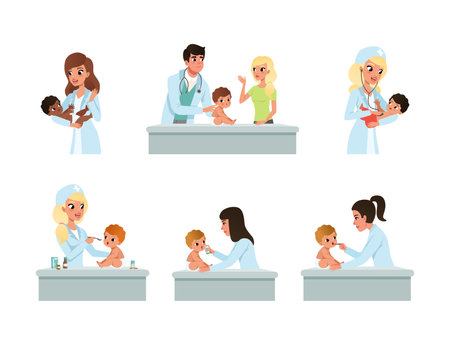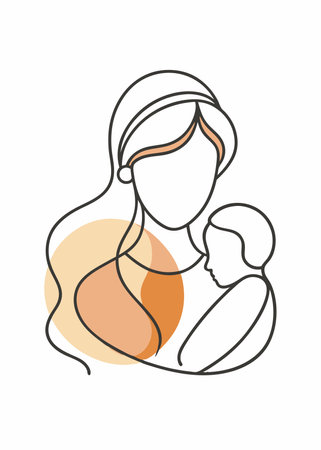1. Choosing the Right Baby Carrier
Choosing the right baby carrier is essential for both your babys safety and your comfort. There are several types of carriers, each with its own benefits. The best choice depends on your babys age, weight, and how you plan to use it.
Types of Baby Carriers
Here are the most common types of baby carriers:
| Type | Description | Best for |
|---|---|---|
| Wraps | A long piece of fabric that wraps around your body to hold the baby snugly. | Newborns and young infants |
| Slings | A fabric loop worn over one shoulder, creating a pouch for the baby. | Newborns and breastfeeding moms |
| Soft Structured Carriers (SSC) | Padded carriers with adjustable straps and buckles for support. | Infants and toddlers |
| Mei Tais | A combination of a wrap and SSC, featuring a structured body panel with tie straps. | Younger babies to toddlers |
| Hiking Backpacks | A structured carrier designed for long walks and hikes. | Toddlers and older babies who can sit upright |
Selecting the Best Carrier for Your Baby
The right carrier should provide proper support for your babys hips and spine while keeping them comfortable. Here are some key factors to consider:
Your Baby’s Age and Weight
Younger babies need more head and neck support, making wraps or slings ideal. As they grow, soft structured carriers or backpacks offer better weight distribution.
Your Comfort Level
If you plan to wear your baby for long periods, choose a carrier with padded shoulder straps and lumbar support to reduce strain on your back.
The Carriers Adjustability
An adjustable carrier allows you to customize the fit as your baby grows, ensuring continued comfort and safety.
The Ease of Use
If youre new to babywearing, a soft structured carrier with buckles may be easier to use than a wrap that requires tying.
Selecting the right baby carrier ensures both you and your little one stay comfortable and secure. Once youve chosen one, its important to learn how to wear it properly for maximum safety!
2. How to Wear Your Baby Carrier Properly
Wearing a baby carrier correctly is essential for both your babys safety and your own comfort. Follow these step-by-step instructions to ensure a secure and comfortable fit.
Step 1: Choose the Right Carrier for Your Baby’s Age
Different baby carriers are designed for various stages of development. Make sure you are using one that supports your baby’s weight and age appropriately.
| Baby’s Age | Recommended Carrier Type |
|---|---|
| Newborn (0-3 months) | Wraps or soft structured carriers with newborn inserts |
| 4-6 months | Soft structured carriers with adjustable support |
| 6+ months | Structured carriers with forward-facing or back-carry options |
Step 2: Adjust the Straps and Buckles Before Placing Your Baby In
A properly adjusted carrier ensures even weight distribution and prevents discomfort. Before putting your baby in, adjust the straps so they fit snugly but not too tight.
Step 3: Secure Your Baby in the Correct Position
The “M” Position for Healthy Hips
Your baby’s legs should be in an “M” shape, with their knees higher than their bottom to support healthy hip development.
Tightness Check
The carrier should be snug enough to keep your baby close but allow you to slip two fingers between their chest and the fabric.
Step 4: Ensure Proper Head and Neck Support
If your baby is younger than six months or cannot hold their head up independently, ensure their head is well-supported by the carriers fabric or an adjustable headrest.
Step 5: Perform a Final Safety Check
- Tight: The carrier should hold your baby snugly against you without any loose fabric.
- Close Enough to Kiss: Your baby’s head should be high enough that you can easily kiss the top of it.
- Keeps Chin Off Chest: Make sure your baby’s chin is not pressed against their chest to prevent breathing issues.
- Straight Back: Your babys back should be naturally curved but well-supported.
Troubleshooting Common Fit Issues
| Issue | Possible Solution |
|---|---|
| Pain in shoulders or back | Tighten shoulder straps and distribute weight evenly across hips |
| Buckle feels loose after wearing | Double-check all fasteners and tighten as needed |
| Your baby seems uncomfortable | Ajust leg positioning to ensure proper hip support |
A well-fitted carrier should feel comfortable for both you and your baby. Take the time to make adjustments as needed, and always check for safety before heading out!

3. Baby Positioning and Ergonomics
Ensuring your baby is positioned correctly in a carrier is essential for their comfort, safety, and healthy development. Proper positioning helps support their spine, hips, and neck while preventing discomfort or potential injury. Below, we’ll go over key factors to consider when wearing your baby in a carrier.
Importance of Proper Positioning
Babies have delicate developing bodies, so using an ergonomic position ensures they are safe and comfortable while being carried. One of the most important aspects of proper positioning is supporting healthy hip development to reduce the risk of hip dysplasia.
The “M” Position for Healthy Hips
The best way to carry your baby is with their legs in an “M” shape—knees higher than their bottom and thighs supported. This position promotes natural hip development and prevents stress on the joints.
| Proper Positioning | Avoid These Mistakes |
|---|---|
| Baby’s knees are above or level with their hips (forming an “M” shape) | Baby’s legs hanging straight down without support |
| Baby’s back is naturally curved in a “C” shape for newborns | Babys spine is unnaturally straight or forced into an arched position |
| Baby’s head is close enough to kiss | Baby’s chin is pressed against their chest, restricting airflow |
Tight but Comfortable Fit
Your baby should be snug against your body without slumping or sagging. A loose fit can cause discomfort and put strain on their developing muscles. Keep these points in mind:
- Tight Enough: The carrier should hold your baby securely, ensuring their airway remains clear.
- Nose and Mouth Uncovered: Always check that fabric isn’t covering your baby’s face to prevent suffocation risks.
- No Slouching: Newborns especially need good neck and back support to maintain a safe posture.
Avoid Overstretching Baby’s Hips
Certain carriers force babies’ legs to stretch too far apart, which may contribute to hip issues. Choose a carrier that supports babys thighs and keeps their legs in the proper “M” shape.
Avoid Forward-Facing Too Early
If using a forward-facing position, wait until your baby has strong neck control (usually around 6 months). Even then, limit forward-facing time to avoid overstimulating your little one.
4. Safety Tips While Babywearing
Keeping your baby safe while using a carrier is the top priority. Proper positioning, secure straps, and good airflow are all essential for a comfortable and secure experience. Follow these safety tips to ensure your baby stays safe and snug.
Check for Proper Airflow
Always make sure your baby has enough airflow while in the carrier. Their face should be visible at all times, and their nose and mouth should never be pressed against fabric or your body.
- Keep babys chin off their chest to prevent airway blockage.
- Avoid covering their face with blankets or extra fabric.
- Regularly check that their breathing is steady and unobstructed.
Ensure Proper Head Support
Newborns and young infants need extra head support since they cannot hold up their heads yet. Make sure your carrier provides adequate support for their neck and head.
- The back of the babys head should be gently supported without forcing their chin down.
- If using an adjustable carrier, ensure the headrest is properly secured.
- Avoid loose or floppy positioning that might cause their head to tilt too far forward.
Secure Strap Adjustments
A well-fitted carrier ensures both you and your baby stay comfortable and safe. Straps should be adjusted snugly but not too tight.
| Adjustment Area | What to Check |
|---|---|
| Shoulder Straps | Snug but not digging into shoulders |
| Waist Belt | Sits securely on hips for even weight distribution |
| Buckle Clips | Fully locked and checked for any looseness |
The “T.I.C.K.S.” Rule for Babywearing Safety
The T.I.C.K.S. rule is a simple way to remember babywearing safety:
- Tight: Keep the carrier snug so your baby stays close.
- In view at all times: Always see your baby’s face without obstruction.
- Close enough to kiss: Your baby’s head should be near your chin.
- Keep chin off chest: Ensure proper airflow by keeping their airway clear.
- Supported back: Their back should be naturally curved, not slouched.
5. Common Mistakes and How to Avoid Them
Using a baby carrier can be a great way to keep your little one close while keeping your hands free. However, improper use can lead to discomfort or even safety risks. Here are some common mistakes parents make when using a baby carrier and how to avoid them.
Poor Positioning
One of the most frequent mistakes is incorrect positioning of the baby. A poorly positioned baby may have restricted airflow or improper hip support.
How to Fix It:
- Ensure your baby is in an upright position with their face visible at all times.
- Their chin should not be pressed against their chest to prevent airway obstruction.
- Keep their knees higher than their bottom in an “M” shape to support healthy hip development.
Loose or Too Tight Straps
Straps that are too loose can cause instability, while overly tight straps may lead to discomfort for both parent and baby.
How to Fix It:
- Tighten the straps enough so that the baby is snug against your body but not overly compressed.
- A good rule of thumb: you should be able to fit two fingers between the straps and your shoulders comfortably.
Not Supporting Baby’s Head and Neck
Newborns and younger infants lack strong neck muscles, making proper head support essential.
How to Fix It:
- If your baby is under four months old, ensure that the carrier provides adequate head and neck support.
- Avoid using outward-facing positions for very young babies until they have strong neck control (usually around 6 months old).
Dressing Baby Inappropriately
Dressing your baby too warmly or not warmly enough can cause overheating or discomfort, depending on the weather.
How to Fix It:
| Mistake | Solution |
|---|---|
| Dressing too warmly | Select breathable fabrics and dress your baby in layers that can be easily removed. |
| Dressing too lightly in cold weather | Add an extra layer over both you and the baby, such as a babywearing coat or blanket. |
| Covering babys face with fabric | Avoid covering their face with scarves or hoods to ensure proper airflow. |
Ineffective Weight Distribution
If you experience back pain while wearing a baby carrier, it may be due to improper weight distribution.
How to Fix It:
- Select a carrier with wide, padded shoulder straps and a waistband for better support.
- Tighten the waistband securely around your hips (not your waist) to help distribute weight evenly.
- If carrying for long periods, switch between front and back carrying positions if your carrier allows it.
Ignoring Carrier Weight Limits
A common mistake is using a carrier that does not match your babys weight range, which can compromise safety and comfort.
How to Fix It:
- Always check the manufacturer’s guidelines for weight limits before use.
- If your baby has outgrown their current carrier, consider upgrading to one designed for larger infants or toddlers.
Avoiding these common mistakes will make babywearing safer and more comfortable for both you and your little one. Always follow manufacturer instructions and pay attention to your babys comfort and positioning while using a carrier.


